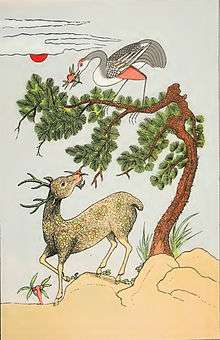Trees in Chinese mythology and cultural symbology
Trees in Chinese mythology and culture tend to range from more-or-less mythological such as the Fusang tree and the Peaches of Immortality cultivated by Xi Wangmu to mythological attributions to such well-known trees, such as the pine, the cypress, the plum and other types of prunus, the jujube, the cassia, and certain as yet unidentified trees. Mythological ideas about trees also extends to various types of fungi which lived or were thought to live underneath certain of these trees, collecting their mysterious essences.(de Groot 1910:296-306)

Pine, cypress, and fir
The pine, cypress, and fir are linked by being similar evergreens. Old pine trees are much admired and venerated.(Eberhard 1986: sub "Pine", 237-238) Some examples of Chinese cultural symbology can be found in the poetry of Six Dynasties poet Tao Yuanming (365?–427). According to Yeh Chia-ying, one of Tao's most frequently used metaphors is that of the pine tree: symbol of ability to withstand the adversity of cold winds, to withstand the adversity of frosts, nevertheless retaining its own essential character: a situation which can be compared with that of certain persons of metaphorically similar character.[1]
Peach, pear, and plum
The peach, pear, and plum are linked by being in the genus Prunus. All three are important in Chinese symbolism.(Eberhard 1986: sub "Peach", "Plum", and "Pear")
Fusang
The Fusang tree appears as a more mythological tree, although sometimes claimed to be just like some kind of mulberry. (De Groot 1910, 306)
Three Friends in Winter
The 'three friends in winter' is a motif frequently seen in Chinese art. The motif consists of pines, bamboos, and plum trees or else plum trees and a stone. The symbolism is that of longevity, constancy, and flowering during winter, before it is yet spring. In Chinese cultural symbology, this motif is considered suitable to send to those who are poor or lonely.(Eberhard 1986: sub "Friends, the Three", 118) The three friends of winter motif is known as early as the Song dynasty work the Jishanji (霽山集), or, in English, the "Clear Mountain Collection" by Lin Jingxi (林景熙), who lived 1242-1310.[2]
Glossary
Chinese terms related to trees in Chinese mythology and cultural symbology:
- Cypress: (Chinese: 柏; pinyin: bǎi)
- Fusang: (Chinese: 扶桑; pinyin: Fú Sāng)
- Peach: (Chinese: 桃; pinyin: táo)
- Pine (sometimes also used for similar evergreen conifers, such as fir): (Chinese: 松; pinyin: sōng)
- Plum: (Chinese: 李; pinyin: lǐ) or (Chinese: 梅; pinyin: méi)
- Three Friends in Winter: (simplified Chinese: 岁寒三友; traditional Chinese: 歲寒三友; pinyin: suìhán sānyǒu) or just (Chinese: 三友; pinyin: sānyǒu)
Gallery
 Porcelain bowel: the peaches symbolize longevity and health, the bats add the idea of good luck and happiness.
Porcelain bowel: the peaches symbolize longevity and health, the bats add the idea of good luck and happiness.- Xi Wangmu on a Qing dynasty porcelain plate, beneath a flowering prunus tree
See also
- Bamboo
- Chinese mythology, for general information
- Four Gentlemen
- Ink stick
- Peaches of Immortality
- Penghou
- Pinus armandii
- Three Friends of Winter
- Wolfiporia extensa
- Xi Wangmu
- Yu Shi
References
- Eberhard, Wolfram (2003 [1986 (German version 1983)]), A Dictionary of Chinese Symbols: Hidden Symbols in Chinese Life and Thought. London, New York: Routledge. ISBN 0-415-00228-1
- De Groot, J. J. M. (1910 [2003]). De Groot, J.J.M. (1910/2003). The Religious System of China. Vol. IV. Kessinger Publishing. ISBN 978-0-7661-3354-9. Accessed on Google Books 7 April 2020.
Web references
- Yeh Chia-ying, translation Josey Shun and Bhikshuni Heng Yin, "Lectures on Tao Yuanming's Poems", a series of lectures at Gold Buddha Monastery, Canada (lecture tapes were transcribed by Tu Xiaoli, An Yi, and Yang Aidi) "Vajra Bhodi Sea: A Monthly Journal of Orthodox Buddhism" No.376, September 2001
- http://www.npm.gov.tw/exh91/3friends/english/infor.htm